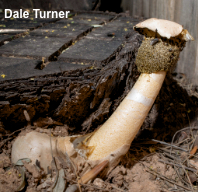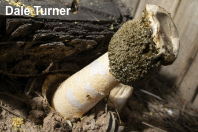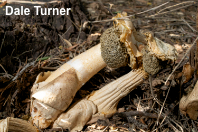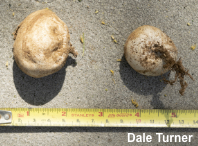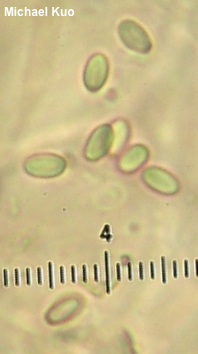| Major Groups > Stinkhorns > Itajahya galericulata |

|
Itajahya galericulata [ Basidiomycota > Phallales > Phallaceae > Itajahya . . . ] by Michael Kuo This amazing stinkhorn wears a hat (a "calyptra," in Biologese), making it fairly easy to recognize. Additionally, the surface of its head is composed of small, wrinkled knots of tissue, unlike the heads of similar-looking (but hat-less) stinkhorns like Phallus ravenelii or Phallus impudicus. Itajayha galericulata has an interestingly disjunct distribution—South America, Texas and the southwestern United States, South Africa, and India—suggesting the possibility that it has been transported by human activity, and leaving us to speculate about which geographic location was its original, "natural" home. Itajahya rosea is virtually identical, but features a pink stem. Preliminary DNA studies (Marincowitz et al. 2015, Melanda et al. 2021) have upheld separation of the two species—and, more tentatively, in my view, separation of the genus Itajahya from Phallus. Phallus galericulatus is a synonym. Thanks to Dale Turner for documenting, collecting, and preserving Itajahya galericulata for study; his collection is deposited in The Herbarium of Michael Kuo. Description: Ecology: Saprobic; growing gregariously in gardens and cultivated areas; summer and fall in the Northern Hemisphere, winter and spring in the Southern Hemisphere; originally described from Brazil; widespread in South America; in North America distributed in Texas and the southwestern United States; well documented in South Africa; reported from India. The illustrated and described collection is from Arizona. Immature Fruiting Body: A whitish "egg" 2–3 cm high and 3–5 cm wide; surface smooth; when sliced revealing the stinkhorn-to-be encased in a gelatinous substance. Mature Fruiting Body: 9–12 cm high; 3–4.5 cm thick at the widest point; more or less cylindric; hollow. Head: 3–4.5 cm high; 3.5–4.5 cm wide; cylindric to slightly egg-shaped; hollow; surface appearing coarsely granular from a distance—the appearance resulting from the surface being composed of small wrinkled nodes of tissue, surrounded by dark brown spore slime; apex adorned with a calyptra—a large cap-like patch of whitish tissue exceeding the width of the head; apex sometimes perforated. Stem: 6–8 cm high; 3–4 cm wide; spongy; hollow; finely pocked; whitish to yellowish; sometimes with adhering patches of volval material; base encased in a whitish to brownish, sacklike volva; attached to thin whitish rhizomorphs. Odor: Foul while the spore slime is present. Microscopic Features: Spores 3–4 x 1.5–2 µm; elongated-ellipsoid; smooth; hyaline in KOH. Sphaerocysts of the pseudostipe 24–52 µm across; subglobose unless compressed, and then irregular; walls 1–1.5 µm thick; smooth; hyaline in KOH. Hyphae of the volva 3–10 µm wide; smooth; thin-walled; septate; hyaline in KOH. Clamp connections not found. REFERENCES: Möller, 1895. (Lloyd, 1909; Long & Stouffer, 1943; Zeller, 1948; Kreisel, 1996; Calonge, 2005; Cabral et al., 2012; Marincowitz et al., 2015; Campi Gaona, 2017; Trierveiler-Pereira et al., 2017; Hernández Caffot et al., 2018; Melanda et al., 2021.) Herb. Kuo 08042101. This site contains no information about the edibility or toxicity of mushrooms. |
|
|
Cite this page as: Kuo, M. (2021, August). Itajahya galericulata. Retrieved from the MushroomExpert.Com Web site: http://www.mushroomexpert.com/itajahya_galericulata.html © MushroomExpert.Com |
